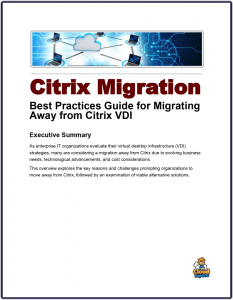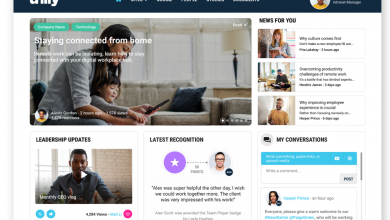Breaking free from Citrix: Migrating Away from Citrix VDI to Parallels Remote Application Server
Parallels RAS delivers comparable functionality with simpler deployment, lower costs, and support for hybrid and multi-cloud environments.
 Organizations are increasingly moving away from Citrix VDI to alternatives like Parallels RAS due to Citrix’s high costs, complex licensing, and resource-heavy administration.
Organizations are increasingly moving away from Citrix VDI to alternatives like Parallels RAS due to Citrix’s high costs, complex licensing, and resource-heavy administration.
The 2022 acquisition of Citrix by Vista Equity Partners and Evergreen Coast Capital has further raised concerns about support and pricing, pushing businesses toward more cost-effective and flexible solutions.
Parallels RAS delivers comparable functionality with simpler deployment, lower costs, and support for hybrid and multi-cloud environments, making it an attractive option for modern digital workplaces.
Parallels RAS
Parallels RAS stands out for its affordability and ease of use. It offers straightforward licensing that reduces total ownership costs compared to Citrix, while its intuitive interface simplifies deployment and management, easing the burden on IT teams.
The platform scales effortlessly across on-premises, cloud, or hybrid setups, adapting to diverse business needs. Users benefit from features like drag-and-drop functionality and universal printing, ensuring a seamless experience across devices. Security is also a priority, with robust encryption, multi-factor authentication, and compliance tools to safeguard data.
Migration Best Practices
Migrating from Citrix VDI to Parallels RAS requires careful planning to ensure success.
Organizations should first assess their current Citrix environment, identifying user needs and infrastructure requirements to set clear migration goals. A pilot test of Parallels RAS can validate its performance and compatibility with existing systems. The migration itself should be executed gradually, moving users and applications while closely monitoring performance to minimize disruptions.
Providing user training and ongoing IT support is essential to address any challenges during the transition. While migration may present hurdles such as compatibility issues or user resistance, these can be managed through thorough planning and clear communication with stakeholders.
A phased rollout, supported by Parallels RAS’s automation tools and resources, helps ensure a smooth transition. By switching to Parallels RAS, organizations can achieve a cost-effective, scalable, and user-friendly virtual desktop solution, enhancing their digital workplace efficiency without compromising performance.



